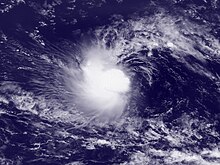中心密集云团区
中心密集云团区(英语:Central dense overcast,简称:CDO)是围绕热带气旋之中心的大型云团区域,由其眼壁的发展而形成。它可以是圆形、有角、椭圆形或不规则的形状[1],这个特征出现在热带风暴或飓风强度的热带气旋中。在风暴达到飓风强度后,风眼就会在中心密集云团区的中心形成。中心密集云团区与风眼的距离以及中心密集云团区内的云与风眼之间的温差有助于确定热带气旋的强度。强度不断变化的热带气旋在其中心密集云团区内,有比稳定的风暴更多的闪电。使用卫星图像中热带气旋的中央密集云团区也可用于确定其强度。热带气旋中的最高持续风速以及最高的降雨量通常位于中央密集云团区的最冷云层之下。

特征
编辑它是围绕在卫星云图上热带气旋中心的大面积雷暴[2][3][4]。当热带气旋的眼壁开始发展,其中央密集云团区便会形成[5];其发展之前可以是窄而密集的C形对流带。在发展初期,云团区的形状通常是有角或椭圆形的,随着热带气旋增强,云团区的尺寸逐渐增大,并且显得更为圆滑[6],并形成成熟的螺旋云带。在低垂直风切变的环境中,中心密集云团区会较圆[3] 。热带气旋中恶劣的天气位于中央密集云团区内最深的对流;但对于处于稳定状态的热带气旋,中央密集云团区内几乎完全没有闪电活动[7]。
热带气旋内最强的风一般是位于中心密集云团区内最深的对流下,在卫星图像上会被显示为最冷的云顶。[8]最大风速半径通常在中心密集云团区最冷的云层范围内[8],亦为热带气旋降雨最强的区域[9]。对于处于较稳定状态的成熟热带气旋来说,中心密集云团区几乎不会有任何闪电活动,而闪电通常会在较弱的热带气旋及强度不断变动的风暴中更为常见。[10]
风眼
编辑中央密集云团区中心的风眼是天气平静的地区。风暴的风眼是一个大致圆形的区域,直径通常是30-65公里。气旋最低的气压会在风眼测得,可能比风暴以外的大气压力低15%[11]。但在较弱的热带气旋中,风眼不会太清晰[11]。
强度预测
编辑在热带气旋的强度估计中,有几种模式可以用来确定其强度的上限和下限。中央密集云团区模式是其中之一,利用中央密集云团区的大小来预计,同时也会考虑中央密集云团区的形状。风眼越靠近云团区,风暴越强劲。中央密集云团区模式强度从热带风暴强度开始,相当于每小时64公里[12][13]。
同时,中心密集云团区的范围增大,是热带气旋逐渐增强的其中一个特征。
但在每小时105公里和每小时160公里之间最高持续风速的热带气旋可能会令可见光和红外卫星图像上的中心变得模糊,致使判断其强度成为一个更大的挑战[14]。
参考来源
编辑- ^ Dvorak, Vernon F. A Technique For the Analysis and Forecasting of Tropical Cyclone Intensities From Satellite Pictures. National Oceanic and Atmospheric Administration: 5–8. 1973-02.
- ^ American Meteorological Society. AMS Glossary: C. Glossary of Meteorology. Allen Press. 2000-06 [2006-12-14]. (原始内容存档于2012-06-22).
- ^ 3.0 3.1 Landsea, Chris. What is a "CDO"?. Atlantic Oceanographic and Meteorological Laboratory. 2005-10-19 [2006-06-14]. (原始内容存档于2006-06-15).
- ^ Hebert, Paul H.; Kenneth O. Poteat. A Satellite Classification Technique For Subtropical Cyclones. National Weather Service Southern Region Headquarters: 9. July 1975.
- ^ Elsner, James B.; A. Birol Kara. Hurricanes of the North Atlantic: Climate and Society. Oxford University Press. 1999-06-10: 3. ISBN 978-0195125085.
- ^ Dvorak, Vernon F. Tropical Cyclone Intensity Analysis and Forecasting From Satellite Imagery. Monthly Weather Review. 1975-05, 103: 422. Bibcode:1975MWRv..103..420D. doi:10.1175/1520-0493(1975)103<0420:tciaaf>2.0.co;2.
- ^ Demetriades, Nicholas W.S.; Martin J. Murphy & Ronald L. Holle. Long Range Lightning Nowcasting Applications For Meteorology (PDF). Vaisala. 2005-06-22 [2012-08-12]. (原始内容存档 (PDF)于2015-10-02).
- ^ 8.0 8.1 Hsu, S. A.; Adele Babin. Estimating the Radius of Maximum Winds Via Satellite During Hurricane Lili (2002) Over the Gulf of Mexico (PDF). February 2005 [2007-03-18]. (原始内容 (PDF)存档于2012-02-06).
- ^ Muramatsu, Teruo. The Study on the Changes of the Three-dimensional Structure and the Movement Speed of the Typhoon through its Life Time (PDF). Tech. Rep. Meteorol. Res. Inst. Number 14. 1985: 3 [2009-11-20]. (原始内容存档 (PDF)于2013-02-08).
- ^ Demetriades, Nicholas W.S.; Martin J. Murphy & Ronald L. Holle. Long Range Lightning Nowcasting Applications For Meteorology (PDF). Vaisala. 2005-06-22 [2012-08-12]. (原始内容存档 (PDF)于2015-10-02).
- ^ 11.0 11.1 Landsea, Chris & Sim Aberson. What is the "eye"?. Atlantic Oceanographic and Meteorological Laboratory. 2004-08-13 [2006-06-14]. (原始内容存档于2006-06-14).
- ^ Velden, Chstopher; Bruce Harper; Frank Wells; John L. Beven II; Ray Zehr; Timothy Olander; Max Mayfield; Charles “Chip” Guard; Mark Lander; Roger Edson; Lixion Avila; Andrew Burton; Mike Turk; Akihiro Kikuchi; Adam Christian; Philippe Caroff & Paul McCrone. The Dvorak Tropical Cyclone Intensity Estimation Technique: A Satellite-Based Method That Has Endured For Over 30 Years (PDF). Bulletin of the American Meteorological Society. 2006-09: 1195–1214 [2012-09-26]. Bibcode:2006BAMS...87.1195V. doi:10.1175/bams-87-9-1195. (原始内容存档 (PDF)于2008-09-17).
- ^ Wimmers, Anthony J.; Christopher S. Velden. Objectively Determining the Rotational Center of Tropical Cyclones in Passive Microwave Satellite Imagery. Journal of Applied Meteorology and Climatology (American Meteorological Society). September 2012, 49 (9): 2013–2034. Bibcode:2010JApMC..49.2013W. doi:10.1175/2010jamc2490.1.
- ^ Wimmers, Anthony; Chistopher Velden. Advances in Objective Tropical Cyclone Center Fixing Using Multispectral Satellite Imagery (PDF). American Meteorological Society. 2012 [2012-08-12]. (原始内容存档 (PDF)于2014-04-08).
参见
编辑外部链接
编辑- 美国国家海洋及大气管理局对其的描述(页面存档备份,存于互联网档案馆)(英文)
- 气象研究所对其的描述(页面存档备份,存于互联网档案馆)(日语)